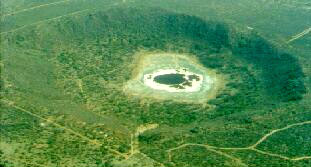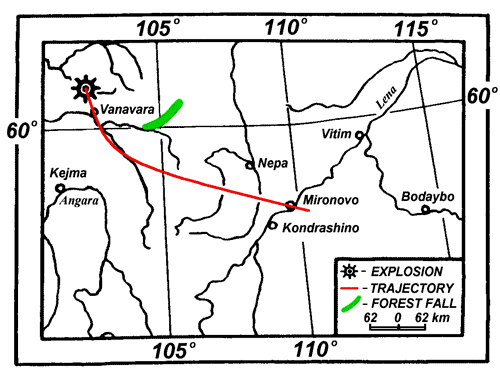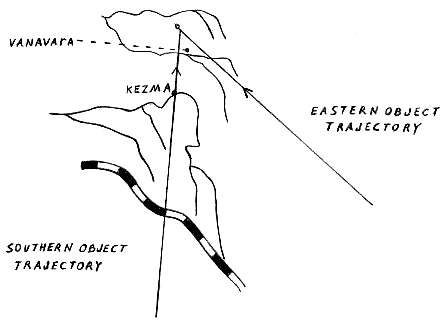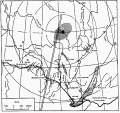|


by
Dave Conklin
from
EarthLink Website
1993-2004
Out of all the folklore that exists
concerning UFOs to date, some of the most interesting stories to me
have always been ones involving the high Arctic. This would include
supposed photos of "discs" appearing from under the Arctic Ice Cap
taken by military recon planes back in the 1940s, and the supposed
crash of an object and sightings of
UFOs near the island of Spitsbergen
along the Arctic Circle. The Arctic Ocean is without question the
Earthís ultimate hiding place if technology permitted. A large deep
cold ocean with relatively shallow peaks and ridges with the added
bonus of a permanent covering of ice and an unforgiving surface
climate. If the Arctic Ocean is being used as some sort of
alien
outpost, there is one geographic point I would like to make.

That - unlike Antarctica, which is of
course a continent almost completely surrounded by ocean, the Arctic
ocean is almost completely surrounded by land. I would think it
likely then that any aliens venturing out from their arctic base -
if they wanted to avoid being noticed, would tend to choose a high
altitude course over the most sparsely populated terrain. I may have
stumbled across some previously overlooked evidence that would
support the use of a particular "corridor" and also demonstrates a
possible connection between UFOs and whatís come to be known as the
Tunguska explosion.
I was reading a well regarded book one day on the subject of UFOs
entitled UFO Exist! copyright 1976 Paris Flammonde - third printing
1987. On page 132 is an excerpt from a 1929 travel diary written by
a Russian explorer while on an exploratory expedition through
Mongolia. The passage describes his caravans encounter with an
unusual object in the sky and the general location of the caravan. I
remembered reading an article about the Tunguska explosion several
years before and having some vague geographical knowledge I knew
Mongolia was directly south of Siberia. So, with the help of an old
National Geographic world atlas, I located the area described by the
Russian explorer and the location of the Tunguska explosion, and
this is what I found.
 On the morning of June 30th, 1908 at 7:17 am at an altitude of about
25,000 feet, an explosion took place over Siberia that equaled the
explosive force of a large hydrogen bomb. About 30 megatons by some
estimates. The general theory among the scientific community is that
the blast was caused by the mid air explosion of a large meteor.
However, I donít think any scientist would disagree that a powerful
fusion explosion would have caused a virtually identical amount of
destruction. Russian scientists did not manage to begin visiting the
site until 19 years after the event, but managed to put together a
rough idea for the trajectory of the object by interviews with the
local population, which went through further refinements as more
expeditions to the remote area were undertaken. On the morning of June 30th, 1908 at 7:17 am at an altitude of about
25,000 feet, an explosion took place over Siberia that equaled the
explosive force of a large hydrogen bomb. About 30 megatons by some
estimates. The general theory among the scientific community is that
the blast was caused by the mid air explosion of a large meteor.
However, I donít think any scientist would disagree that a powerful
fusion explosion would have caused a virtually identical amount of
destruction. Russian scientists did not manage to begin visiting the
site until 19 years after the event, but managed to put together a
rough idea for the trajectory of the object by interviews with the
local population, which went through further refinements as more
expeditions to the remote area were undertaken.
The following is the excerpt from the 1929 travel diary
Altai-Himalaya written by the Russian explorer Nicholas Roerich
after his expedition through Mongolia, which I am assuming was
published not too long afterwards, it pertains to an area about one
thousand four hundred and fifty miles south of the Tungus crash site
....
On August fifth - something remarkable! We were in our camp
in the Kukunor district, not far from the Humboldt chain. In the
morning about half - past nine some of our caravaneers noticed a
remarkably big black eagle flying above us. Seven of us began to
watch this unusual bird. At the same moment another of our
caravaneers remarked: "there is something far above the bird." And
he shouted in astonishment. We all saw in a direction from north to
south, something big and shiny reflecting sun, like a huge oval
moving at great speed. Crossing our camp this thing changed in itís
direction from south to southwest. And we saw how it disappeared in
the intense blue sky. We even had time to take our field glasses and
saw quite distinctly the oval form with shiny surface, one side
which was brilliant from the sun.
Here is the interesting part: As shown in the diagram below, if the
course of the Tungus object is extended south about eight hundred
and fifty miles it passes directly over the area described by Mr
Roerich and parallels the course of the object he describes.

May 2001.
For those not
familiar with the Tungus explosion and its history: The map I used
for the course trajectory was one proposed by Tungus explosion
researcher Felix Zigel. The "zig" and "zag" at the top represents an
attempt to explain discrepancies in eyewitness information generally
between two groups of people - those people that were south of
ground zero and those that were east of ground zero. Interestingly -
although the east to west trajectory coincides more closely with the
blast pattern, the eyewitnesses apparently all agreed they saw the
object in the afternoon. And the witnesses to the south agree it was
early morning which coincides with the known time of the explosion.
I also found an interesting eyewitness account I had not heard of
before in some documents written by Tungus explosion researcher
Nickolai Vasilyev (pronounced Va-si-ly). To summarize: A Tungus
named Ivan Ivanovich Aksenov claimed that while camped at the mouth
of the Yakuta river - a tributary of the Chamba, in the afternoon
after the explosion a "devil" shaped like a Billet - a rectangular
object - flew southward along the Chamba river faster than an
airplane. He also describes the object as being light in color, two
eyes in front, fire behind, and making a quiet "troo-troo" sound. I
am not sure at present as to when the man was first interviewed
whether it was by the first expeditions or much later but keep in
mind the Tungus people in 1908 were still very isolated and
superstitious.
Dec 2002.
The N.V. Vasilyev link has been broken and it looks like
all of his web pages have been removed from the web. I have learned
from the web that he passed away as of Febuary 15th of last year.
And his wife - Dr. Titiana Kolyada, is
finishing a book Nickolai was
working on at the time of his death.
Iíve pieced together a brief overview of some of the arguments that
have been made in support of the exploding spacecraft theory as well
as a few against it.
FOR
1 According to the exploding
meteor theory the object would have had to enter the atmosphere
at a speed no less than 60,000 mph. And at just the right angle
(45 degrees) to avoid skipping back into space or hitting the
ground prematurely. Even though 60,000 mph is at the slow end of
the spectrum for meteors, the object should have been fleeting.
As far as calculating the exact time the object should have been
visible, the math is a bit beyond me. However, I can offer these
facts for comparison. The average speed of a meteor is about
100,000 mph with fast ones moving about 125,000 mph. They begin
to noticeably glow at about 80 miles high. The Space Shuttle,
upon re-entry, begins to glow at the same altitude at a speed of
15,000 mph and crosses from horizon to horizon in about three
minutes. Based on these facts Iím guessing that, even at a
shallow angle, the Tunguska object would have crossed from
horizon to horizon in no more than about 40 seconds at 60,000
mph. At a 45 degree angle the meteor becomes even more fleeting;
passing through the atmosphere in only 6 to 7 seconds. Yet
witnesses describe the object as moving slow, some watching it
for a full 10 minutes. (More than one study of the eyewitness
accounts has also suggested a slow moving object).
2 The axis of the blast pattern, probably caused by
the objects ballistic wave (in conjunction with the blast wave),
is different than the "best" eyewitness trajectory.
3 The locals reported sicknesses among people who
had experienced the heat of the explosion or had visited the
blast area; along with unusual scabs or sores developing on
reindeer herds that survived the explosion. Loose-knit evidence
to be sure, but consistent with radiation poisoning.
4 If the object were indeed a large meteor
traveling at 60,000 mph, its surface should have been heated to
temperatures comparable to the surface of the sun - about 7,000
degrees F; causing material to melt off and burn away right up
until impact. Yet there is no mention by witnesses of the object
leaving the thick billowing smoke trail typically associated
with large burning meteors, but rather broad, whispy,
multi-colored streaks.
5 The object, estimated at about 150 feet in length,
all but vaporized leaving not a single trace of any appreciable
size / the exploding meteor theory has not been proven.
6 People received mild flash burns some 40 miles
from the blast suggesting the heat of the blast was in the
millions of degrees. Or they were also hit by ionizing radiation
- (gamma rays).
7 If there was no significant amount of material
burning away from the object, the object should have been bright
right up until impact due to its intense heat and a surrounding
layer of superheated ionized air. Yet some witnesses describe
the object as only luminous or "black".
8 The eyewitness accounts suggest a shallow angle
of entry of 5 to 17 degrees, while the blast pattern suggests a
steeper angle of 30 to 40 degrees.
AGAINST
1 The objectís
trajectory was actually a curving one, curving from a west to a
north one; hence the differing eyewitness testimony. [This
theory does not explain the time difference between the
witnesses. And I, for one, simply can not visualize how how a
potato shaped meteor traveling at 60,000mph, that was by all
accounts not even spinning, could seemingly defy the laws of
physics and change course parallel to the Earth.]

2 A drawing of the object, by a local, looks like
a small asteroid. [I donít have much of a rebuttal for this one
- his drawing does look like an asteroid. However, if it was a
large spacecraft of some kind that began to burn up on re-entry,
it might have resembled an elliptical shaped asteroid.]
3 Other witnesses report the object as being
very bright.
4 Absence of radioactive fallout or
radioisotopes such as carbon 14. [Elevated amounts of Carbon 14
have been found, but not nearly what should have been left by a
fusion or anti-matter explosion.]
5 There is no scientific proof of the
existence of extraterrestrial vehicles.
The eyewitness drawing by T.N. Naumenko
from Kezma, June 30, 1908. Mr. Naumenko described the object as "a
luminous moon sized cloud."

April 2003
Olaf Jansenís
story written in....1908. An encounter with an alien transportation
device ie; stargate? Or just a fairy tale? Entertaining whatever the
case.
The Smoky God, Or A Voyage to the Inner World.
May 2003
I did some surfing to see if there were any
more stories on the net concerning UFOs in the polar regions. I
didnít find much. The most interesting item I found was a reference
to a statement supposedly made to a Chilean newspaper by
Admiral
Richard E. Byrd on March 5th, 1947 during his participation in
Operation Highjump. Operation Highjump being a late forties
Antarctic military operation. His statement was to the effect that
[he did not want to frighten anyone unduly but it was a bitter
reality that in case of a new war the continental United States
would be attacked by flying objects which could fly from pole to
pole at incredible speeds.] Make of it what you will. Other than
that I ran across a couple of short undated stories about UFOs
breaking through pack ice on a website entitled
Water UFO Research.
Oct 2003
If you have previously visited this web site you will
notice that a lot of stuff is missing. I decided that, unlike my JFK
page, the UFO page had become bloated with information that was
generally useless and off subject, starting in July 02 with a
Chinese news release about a pyramid discovered in Tibet that was no
doubt a fabrication. I have decided to archive some of the entries
(trim the fat so to speak) and refocus on evidence that supports (or
does not support) the exploding spacecraft theory.
The Roerich sighting took place August 5, 1927. Two months and one
week after
Leonid Kulik first arrived at the
epicenter of the
Tunguska explosion on May 30, 1927.
Addition to arguments against an
exploding spacecraft #3
As far as the "no radioactive
fallout" argument is concerned it looks as though it is pretty
much a non-argument. This is due to two things, the high
altitude of the explosion and the time interval between the
explosion and the first radiation tests. Common sense would say
that if an explosion a few thousand feet in the air (Hiroshima)
sent most of the fallout into the stratosphere, then an
explosion five miles up would certainly deposit even the
heaviest fallout particles far downwind from ground zero. Add
that to the fact that fifty years had elapsed between the
explosion and the first radiation tests and the no radioactive
fallout argument doesnít hold up. The carbon 14 argument is
somewhat stronger though. Carbon 14 is a "long lived"
radioactive isotope that occurs when neutrons freed by an atomic
reaction interact with nitrogen. If I understand correctly, this
can take place in the atmosphere, in the trees and soil
directly, and can also be absorbed by trees and other vegetation
from the atmosphere. Scientists have only found evidence of a
slight increase in worldwide carbon 14 levels from the year
after the explosion. No elevated levels of carbon 14 have been
found near the epicenter of the explosion despite a Russian
scientists initial claims to the contrary.
The paragraph below is from page 251 of
Col. Philip J. Corsoís book
The Day After Roswell paperback edition
June 1998.
During the years I was at the White
House, the UFO working group had consistently pushed
President
Eisenhower to establish a string of formal listening posts -
electronic pickets staffed by army and air force observers at
the most remote parts of the planet - to report on any UFO
activity. General Twiningís group had argued that if the
EBEs
had any plans to establish semi permanent Earth bases, it
wouldnít be in a populated area or an area where our military
forces could monitor. It would be at the poles, in the middle of
the most desolate surroundings they could find, or even
underneath the ocean.
The polar caps seemed like the most
obvious choices because during the 1950s we had no surveillance
satellites that could spot alien activity from orbit, nor did we
have a permanent presence at the two poles. It was thought that
we wouldnít be able to put any sophisticated devices at the
poles, either, because doing so would require more power than we
could transport. However, the armyís Nuclear Power Program,
developed in the 1950s at Fort Belvoir, provided us with the
ability to install a nuclear-powered base anywhere on the
planet.
Copyright 1997 Rosewood Wood Productions, Inc.
Addition to arguments for the
exploding spacecraft theory #6
Proponents of the meteor theory have speculated that the mild flash
burns received by people many miles south-southeast of the
epicenter, at the trading post of Vanavara, were actually caused by
the radiant heat of the object as it passed overhead. This is a good
argument for the meteor theory. But again, it ignores the eyewitness
accounts from south-southwest of the epicenter and assumes the
object was moving at a great speed. According to one translation I
have of S. B. Semenovís description from Vanavara, the heat blast
came from the north. Itís unfortunate that those witnesses that
described a large blast of heat were all to the south or southeast
of the explosion. As far as I know, the area to the north and
northwest of the epicenter (completely away from any possible
trajectory) was unpopulated at the time of the explosion.
After casually studying the Tunguska explosion for some 25 years, I
am going to put forth a theory that attempts to explain a lot of the
discrepancies concerning the Tunguska explosion. It moves away
somewhat from the traditional "accidental" explosion idea and is
entirely speculative, but right or wrong, at least it does not
completely ignore the eyewitness testimony that does not support a
high speed meteor strike. Call it - a modern theory for an old
mystery. The suggestion is - the Tunguska explosion involved not
one, but two objects.
-
The first object resembled a large black
meteor surrounded by a reddish cloud, but was not moving faster than
about 2500 mph at the time of the explosion, possibly much slower.
It traveled from south to north and had a long, bright, bluish white
tail, which was apparently visible right up until the explosion.
The object was nothing short of a
disguised missile or large lifting body-like vehicle. Whatever
substance was used to fuel or disguise the vehicle burned away so
completely that only a whispy contrail was left behind. The vehicle
was intercepted at a predetermined location by a second object
traveling from the southeast to northwest.
-
The second object was
traveling much faster; entered the atmosphere at a steeper angle;
produced a powerful ballistic wave; and might even have been some
type of particle weapon. The first object was all but vaporized in a
tremendously hot explosion that did not produce the neutron
radiation associated with atomic explosions. The explosion was
detonated over a patch of forest to leave a temporary record of the
event. And detonated over an unpopulated region to avoid civilian
casualties.
Later on that afternoon the area was visited by whoever
caused the explosion.
SIDE NOTE: I am presenting this theory without having
personally reviewed all of the eyewitness accounts, which have been
cataloged in Russian, but have not (to my knowledge) been completely
translated into English. The exact number of eyewitness or witness
accounts is a bit hard to judge because some of the accounts
collected in the 60s and 70s could have been other events. Roughly
speaking there are about 500. (Info provided by Andrei Olíkhovatov)
A good site that presents some interesting ideas and contains more
than the usual bit of information about the eyewitness accounts.
Tunguska event of 1908 was to be of
geophysical origin!

March 2004
The main
question I seem to be getting since posting my theory is - why would
someone deliberately attack a forest? Who knows for certain? But,
here is some food for thought; Obviously, anyone who could strike
targets on Earth at will or moving targets in Earthís atmosphere
from space with such precision and force would have a tremendous
strategic advantage. And therefore the ultimate bargaining chip to
say - recover downed reconnaissance vehicles, or defend an Earth
base. Remember Reaganís "Star Wars" program back in the early
eighties? But again, I am delving into areas of complete
speculation. Or perhaps there was no other reason then to make us
think that a natural event occurred over Central Siberia. After all,
the scientific community and "anti-nuke" people, of which I am one,
constantly refer to the Tunguska explosion and its remarkable
similarity with an atmospheric nuclear explosion, in reminding us
that an "accident" could happen. A foresighted gesture to save us
from ourselves? Perhaps we all should just embrace the asteroid
theory for the common good, but then again; there may be no proof
that the Tunguska object was a meteor, but there is also no proof
the object was anything other. Cíest la vie.
August 2004
Nickolai Vasilyevís book entitled
The
Tunguska Meteorite has been published posthumously in Russia.
Here is a strange statement that I have not been able to
substantiate. It appears on page 79 of The Fire Came By 1976
Baxter/Atkins.... Although some Tungus had reported finding unusual
bits of shiny metal "brighter than the blade of a knife and
resembling in color a silver coin," Kulikís sensitive instruments
detected nothing.
To elaborate a little more on my inspiration for the particle
weapon; The eyewitness accounts, although open to some
interpretation, seem to suggest that during, or immediately after
the object flattened into a saucer shaped black cloud, a peculiar
"shaft" of light or flame shot from the cloud. Described thusly:
-
Kirensk - "A fiery pillar in the form of a spear"
-
Nizhne Karelinsk
- "Turned into a fiery pillar and disappeared in a moment"
"A
forked tongue of flame broke through the cloud"
-
Krasnoyarsk
newspaper 1908 - "A huge flame shot up and cut the sky into"
-
Vanavera - "The sky was split into"
Herein lies the problem; If the strange shaft of light they are
describing was an actual flame, it would suggest a slow burn. And
that, of course, doesnít fit the picture that has been put forth of
an exploding meteor. The only thing that I could imagine personally
that could cause such an instantaneous pillar of flame is a jet of
highly flammable, lighter than air gas; Hydrogen being the best
candidate. But you still have a blast pattern that does not line up
with the best eyewitness trajectory. Reading these descriptions out
of the context, one might think that the witnesses were actually
attempting to describe the mushroom cloud. However, most of the
witnesses go on to quite accurately describe the mushroom cloud.
Who knows what to make of this. I myself remain quite skeptical,
especially since the report came from Pravda.
Explorers find fragments in Tunguska meteorite
Just some items from my "Tunguska library" I decided to post that I
have not seen on any other website. The photo below is a
micro-barograph recording of the Tunguska explosion. A barograph is
an instrument that records changes in air pressure, not to be
confused with a seismograph, which, of course, measures earthquake
magnitude. As you can see, the Tunguska explosion appears to be
separated by two distinct events. A low frequency event followed by
a high frequency event more similar to a nuclear explosion.

 Right (click
image) is the first trajectory map created from eyewitness
accounts. It was put together by A.V. Voznesensky, former head of
the Irkutsk Observatory, in the mid 1920s and used by Kulik in his
search for the epicenter. Right (click
image) is the first trajectory map created from eyewitness
accounts. It was put together by A.V. Voznesensky, former head of
the Irkutsk Observatory, in the mid 1920s and used by Kulik in his
search for the epicenter.
Sept
2004,
In light of the recent "hoopla"; Some more info for the
Tunguska surfer that I havenít seen on the web.
Addition to arguments for the exploding spacecraft theory #1
To
elaborate a bit further on the studies of the eyewitness testimony
that suggests a slow moving object; Felix Zigel, the Russian
aerodynamics professor mentioned earlier, pointed out that because
some witnesses saw the object and heard the sonic boom
simultaneously, the object could only have been traveling at a speed
somewhere between the speed of sound (750mph) and a few miles per
second (about 10,000mph). If the eyewitness accounts support his
claim, he is indeed correct. If the object were travelling anywhere
close to 60,000mph as the meteor theory predicts, no-one should have
heard the sonic boom from the object until it had past by, and was
on the far horizon.
The second study was done by A.Y. Monoskov, an aircraft designer
with the Antonov group. He composed a map with the time the object
had been spotted by different witnesses superimposed along the
trajectory, and came to the conclusion the object slowed along its
trajectory to a speed of only 1,500mph.
Yet another Soviet geophysicist named Aleksey V. Zolotov set the
speed of the object at 7,000mph based on the effects of the
ballistic wave on the trees in the destroyed area.
|

 On the morning of June 30th, 1908 at 7:17 am at an altitude of about
25,000 feet, an explosion took place over Siberia that equaled the
explosive force of a large hydrogen bomb. About 30 megatons by some
estimates. The general theory among the scientific community is that
the blast was caused by the mid air explosion of a large meteor.
However, I donít think any scientist would disagree that a powerful
fusion explosion would have caused a virtually identical amount of
destruction. Russian scientists did not manage to begin visiting the
site until 19 years after the event, but managed to put together a
rough idea for the trajectory of the object by interviews with the
local population, which went through further refinements as more
expeditions to the remote area were undertaken.
On the morning of June 30th, 1908 at 7:17 am at an altitude of about
25,000 feet, an explosion took place over Siberia that equaled the
explosive force of a large hydrogen bomb. About 30 megatons by some
estimates. The general theory among the scientific community is that
the blast was caused by the mid air explosion of a large meteor.
However, I donít think any scientist would disagree that a powerful
fusion explosion would have caused a virtually identical amount of
destruction. Russian scientists did not manage to begin visiting the
site until 19 years after the event, but managed to put together a
rough idea for the trajectory of the object by interviews with the
local population, which went through further refinements as more
expeditions to the remote area were undertaken. 




